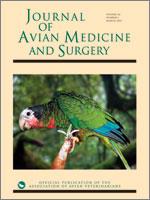Marbofloxacin, a fluoroquinolone developed specifically for veterinary use, has demonstrated considerable pharmokinetic variation among avian species. The goal of this study was to determine the disposition kinetics of marbofloxacin in mallard ducks (Anas platyrhynchos) after a single intravenous injection. Six wild mallard ducks were used in the study. Marbofloxacin was injected at a dose of 2 mg/kg into the basilic vein, and blood was subsequently collected at regular intervals from each bird. Plasma marbofloxacin concentrations were determined by using high-performance liquid chromatography. The volume of distribution at steady state was 1.78 ± 0.37 L/kg, and the total plasma clearance was 0.59 ± 0.08 L/kg per hour. Marbofloxacin had a relatively short permanence, with a elimination half-life of 2.81 ± 1.20 hours, a terminal half-life of 2.43 ± 0.61 hours, and a mean residence time of 2.99 ± 0.52 hour. The maximum observed concentration (Cmax) and area under the curve (AUC) were 1.34 ± 0.27 µg/mL and 3.75 ± 0.56 µg · h/mL, respectively. Values of minimum inhibitory concentration (MIC), Cmax, and AUC have been used to predict the clinical efficacy of a drug in treating bacterial infections, with a Cmax ∶ MIC value of 10 and an AUC ∶ MIC ratio of 125–250 associated with optimal bactericidal effects. By using the study data and MIC breakpoints of 0.125 µg/mL or 0.2 µg/mL, values derived for Cmax ∶ MIC were 9.37 ± 0.99 and 5.85 ± 0.62, respectively, and for AUC ∶ MIC were 29.99 ± 4.51 and 18.74 ± 2.82, respectively. By using MIC values of 0.125 and 0.2 µg/mL and a target AUC ∶ MIC = 125, the calculated optimal daily marbofloxacin dosages for mallard ducks were 9.24 and 14.78 mg/kg, respectively. These results suggest that, primarily because of the high total plasma clearance observed, the marbofloxacin dose for treatment of bacterial diseases in mallard ducks should be increased after intravenous administration. Intravenous doses of 10–15 mg/kg should be assessed by studying their potential toxicity and efficacy in sick birds.
How to translate text using browser tools
1 March 2012
Marbofloxacin Disposition After Intravenous Administration of a Single Dose in Wild Mallard Ducks (Anas platyrhynchos)
Marino Garcia-Montijano,
J. Julio de Lucas,
Casilda Rodríguez,
Fernando González,
Manuel Ignacio San Andrés,
Samanta Waxman
ACCESS THE FULL ARTICLE
Anas platyrhynchos
anseriform
antibiotic
Avian
fluoroquinolone
mallard duck
marbofloxacin





